 The monumental sculpture of the goddess Diana by Augustus Saint-Gaudens which once graced the tower of the second Madison Square Garden (we’re on the fourth one now) and now graces the Great Stair Hall of the Philadelphia Museum of Art will soon return to her brilliant gilded shine. Funded by Bank of America, the project is expected to take about four months during which conservators will research the original construction of the statue, its appearance when new, its current condition. Corrosion on the green bronze surface will then be removed to make it ready for the application of 180 square feet of gold leaf.
The monumental sculpture of the goddess Diana by Augustus Saint-Gaudens which once graced the tower of the second Madison Square Garden (we’re on the fourth one now) and now graces the Great Stair Hall of the Philadelphia Museum of Art will soon return to her brilliant gilded shine. Funded by Bank of America, the project is expected to take about four months during which conservators will research the original construction of the statue, its appearance when new, its current condition. Corrosion on the green bronze surface will then be removed to make it ready for the application of 180 square feet of gold leaf.
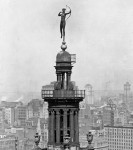 The gold on this icon of the Gilded Age was eroded over the 32 years Diana spent exposed to the harsh elements of New York City. She was installed 347 feet above street level on the Moorish style tower Stanford White designed inspired by Giralda, the bell tower of the Cathedral of Seville, where she towered over the city, the highest point in town and by far the shiniest. She was so bright that when the sun hit her she could be seen as far as away as the Hudson River and even New Jersey. Not even the dark night could dampen her gleam, thanks to the electrical lights that illuminated her. Diana was the first statue in the city to be lit with electricity.
The gold on this icon of the Gilded Age was eroded over the 32 years Diana spent exposed to the harsh elements of New York City. She was installed 347 feet above street level on the Moorish style tower Stanford White designed inspired by Giralda, the bell tower of the Cathedral of Seville, where she towered over the city, the highest point in town and by far the shiniest. She was so bright that when the sun hit her she could be seen as far as away as the Hudson River and even New Jersey. Not even the dark night could dampen her gleam, thanks to the electrical lights that illuminated her. Diana was the first statue in the city to be lit with electricity.
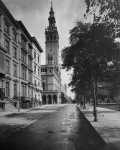 Stanford White’s Madison Square Garden opened in 1890. White commissioned his friend Saint-Gaudens to make the statue as a weathervane, combining a classical theme, Beaux Arts luxury and an all-American folk art form. The one now in the Philadelphia Museum of Art was actually the second Diana to alight the tower. The first version debuted in October 1891 and was much larger, an 18-foot-high huntress which weighed 1,800 pounds. White decided she was too big, that her proportions didn’t suit the tower. Besides, she was too heavy to actually turn in the wind, which is kind of the point of even so decorative a weathervane.
Stanford White’s Madison Square Garden opened in 1890. White commissioned his friend Saint-Gaudens to make the statue as a weathervane, combining a classical theme, Beaux Arts luxury and an all-American folk art form. The one now in the Philadelphia Museum of Art was actually the second Diana to alight the tower. The first version debuted in October 1891 and was much larger, an 18-foot-high huntress which weighed 1,800 pounds. White decided she was too big, that her proportions didn’t suit the tower. Besides, she was too heavy to actually turn in the wind, which is kind of the point of even so decorative a weathervane.
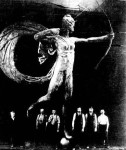 Saint-Gaudens agreed and went to work on a more lithe, streamlined piece. Diana II was 13 feet high and hollow. Her pose was more balletic, her raised leg more extended, her thighs more tapered and less muscular. She was also more naked, something which did not go unnoticed by New York society when she was installed on the tower. The first Diana was taken down in September of 1892 and moved to Chicago. There she was placed atop the dome of the Agriculture Building at the Chicago World’s Fair whose massiveness easily accommodated her dimensions. Sadly, after the Exposition the bottom half of her was destroyed by a fire at the fairgrounds and the top half was lost.
Saint-Gaudens agreed and went to work on a more lithe, streamlined piece. Diana II was 13 feet high and hollow. Her pose was more balletic, her raised leg more extended, her thighs more tapered and less muscular. She was also more naked, something which did not go unnoticed by New York society when she was installed on the tower. The first Diana was taken down in September of 1892 and moved to Chicago. There she was placed atop the dome of the Agriculture Building at the Chicago World’s Fair whose massiveness easily accommodated her dimensions. Sadly, after the Exposition the bottom half of her was destroyed by a fire at the fairgrounds and the top half was lost.
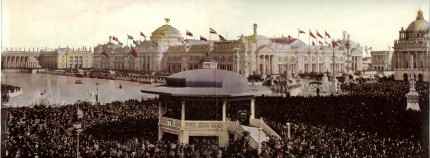
The new Diana was installed in November of 1893. Her nudity made monocles pop and pearls be clutched all over town. Female nudes in public art were not decent, according to some New Yorkers. Others trained telescopes and binoculars on her to take full advantage of the rare sight. Despite the tut-tutting of her early days, Diana of the Tower, as she came to be known, quickly became an icon of the city. Author O. Henry paired her with that other famous New York lady, the Statue of Liberty, in his 1911 short story The Lady Higher Up. He describes Diana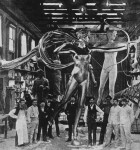 thus:
thus:
The statue of Diana on the tower of the Garden—its constancy shown by its weathercock ways, its innocence by the coating of gold that it has acquired, its devotion to style by its single, graceful flying scarf, its candour and artlessness by its habit of ever drawing the long bow, its metropolitanism by its posture of swift flight to catch a Harlem train—remained poised with its arrow pointed across the upper bay. Had that arrow sped truly and horizontally it would have passed fifty feet above the head of the heroic matron whose duty it is to offer a cast-ironical welcome to the oppressed of other lands.
 Diana was also witness to one of the most lurid scandals in New York history: the murder of Stanford White himself. White’s apartment was in the tower — the advantage of being the architect is you get to make yourself the baddest domicile in town — and he was a regular attendee at Madison Square Garden’s rooftop restaurant under the shadow of tower and Diana. On June 25th, 1906, White was attending the opening night of Mam’zelle Champagne, a musical of little note that is only remembered today for the dramatic events of its premiere, when at 11:00 PM during the closing number I Could Love a Million Girls (see 18:38 of “Homer’s Night Out” for The Simpsons‘
Diana was also witness to one of the most lurid scandals in New York history: the murder of Stanford White himself. White’s apartment was in the tower — the advantage of being the architect is you get to make yourself the baddest domicile in town — and he was a regular attendee at Madison Square Garden’s rooftop restaurant under the shadow of tower and Diana. On June 25th, 1906, White was attending the opening night of Mam’zelle Champagne, a musical of little note that is only remembered today for the dramatic events of its premiere, when at 11:00 PM during the closing number I Could Love a Million Girls (see 18:38 of “Homer’s Night Out” for The Simpsons‘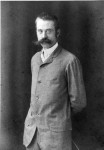 rendition) Henry K. Thaw walked up to White from behind and shot him three times. White died on the spot.
rendition) Henry K. Thaw walked up to White from behind and shot him three times. White died on the spot.
Thaw, heir to coal and rail millions, hated White. He had raped Thaw’s future wife, model, actress and renown beauty Evelyn Nesbit, taking her virginity when she was just 16 years old and ushering her into his company of mistresses who famously cavorted naked in a red velvet swing mounted on the ceiling of his apartment. Before she married him, Nesbit told Thaw that she was no longer a virgin and he exploded with fury. He married her anyway, but he abused her physically, emotionally and sexually. He was obsessed with White, insisting his wife notify him every time she caught a glimpse of him on the street, nursing an ever-increasing resentment that finally exploded that night on the rooftop of Madison Square Garden. He was tried for murder twice. The first resulted in a hung jury (this was the first time a jury in the US was 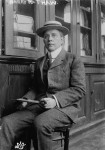 sequestered); the second he was found not guilty by reason of insanity.
sequestered); the second he was found not guilty by reason of insanity.
Although Diana was but a mute spectator to the murder, E.L. Doctorow’s fictionalization of the story Ragtime, later made into a musical, appropriately enough, puts her in the center of things. He made Nesbit the model for Diana whose nudity for all to see atop White’s masterpiece drove Thaw crazy enough to kill. That was a complete fabrication for literary purposes, though. Nesbit was eight years old when Diana was made. The real models were Davida Clark, one of Saint-Gaudens’ favorite models, his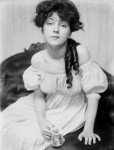 mistress and eventually the mother of his son Louis, for the face and Julia “Dudie” Baird for the body.
mistress and eventually the mother of his son Louis, for the face and Julia “Dudie” Baird for the body.
Even with the naked lady up top and the huge publicity from the White murder and Thaw’s trials, Madison Square Garden never turned a profit. For three decades it hosted major sporting events, horse shows, dog shows, theatrical productions, the 1924 Democratic National Convention, but there wasn’t a single year when it actually made money. The syndicate of investors, men of immense wealth including J. P. Morgan, Andrew Carnegie, P. T. Barnum and W. W. Astor, didn’t get rich by pouring good money after bad so in 1911 they sold it to a real estate company. The real estate company got a mortgage from the New York Life Insurance company which foreclosed in 1916.
The new owners leased it to boxing promoter Tex Rickard who managed to actually make money, but he decided to take the name and build a third Madison Square Garden nowhere near Madison Square. The New York Life Insurance company figured since they had the property, they might as well use it themselves. They weren’t interested in moving into the Stanford White structure, however. They wanted a skyscraper which meant Madison Square Garden II would suffer the same fate so many of White’s Beaux Arts masterpieces in New York City suffered: complete destruction.
 On May 6th, 1925, demolition began. To give credit where credit is due, New York Life Insurance did their utmost to preserve the tower and Diana. Private collectors offered to buy the statue, but the company directors refused. They wanted her to be saved for the city and would only agree to release her to an institution that agreed to preserve her. There were many proposals by various New York institutions for relocating Diana. City Commissioner William Wirt Mills proposed she be relocated above the arch at the Manhattan entrance of Manhattan Bridge. Others thought she should stay in Madison Square, proposing that the tower be taken down brick by brick and rebuilt on the square with Diana on top. None of these prospects went anywhere.
On May 6th, 1925, demolition began. To give credit where credit is due, New York Life Insurance did their utmost to preserve the tower and Diana. Private collectors offered to buy the statue, but the company directors refused. They wanted her to be saved for the city and would only agree to release her to an institution that agreed to preserve her. There were many proposals by various New York institutions for relocating Diana. City Commissioner William Wirt Mills proposed she be relocated above the arch at the Manhattan entrance of Manhattan Bridge. Others thought she should stay in Madison Square, proposing that the tower be taken down brick by brick and rebuilt on the square with Diana on top. None of these prospects went anywhere.
With only weeks to go before scheduled demolition, New York University proposed that they take the tower and statue to grace the courtyard of a campus building designed by Stanford White. New York Life Insurance loved this idea and officially announced this was the solution. They agreed to remove the tower and statue and keep them in storage while NYU raised the money for the relocation. Everything seemed to be in place: donors signed up, permits were in order, but it just never happened. The money never came through.
 The tower was destroyed. New York Life kept the statue in a warehouse in Brooklyn until 1932. By then the new 40-story New York Life Insurance Building had been up and running for four years, and the Metropolitan Museum of Art had acquired a six-foot copy of Diana reproduced from original casts for its collection. (You can see what golden Diana will look like from looking at the Met’s copy which is still bright and shiny.) Finally, the orphaned Diana of the Garden found a home, but it wasn’t in New York; it was the Philadelphia Museum of Art.
The tower was destroyed. New York Life kept the statue in a warehouse in Brooklyn until 1932. By then the new 40-story New York Life Insurance Building had been up and running for four years, and the Metropolitan Museum of Art had acquired a six-foot copy of Diana reproduced from original casts for its collection. (You can see what golden Diana will look like from looking at the Met’s copy which is still bright and shiny.) Finally, the orphaned Diana of the Garden found a home, but it wasn’t in New York; it was the Philadelphia Museum of Art.
The museum had just completed construction on a beautiful $18,000,000 new three-sided building with a central courtyard. There was talk of Diana going in the courtyard, but thankfully they decided to keep her indoors. Conservators  at the time made repairs to the long-neglected statue, repairs which will now be reversed in keeping with a modern conservation ethos. The new restoration will be far more circumspect, not to mention fun for museum visitors. The entire process will be recorded on video and displayed on a monitor near the conservation area for visitors to view the work in progress.
at the time made repairs to the long-neglected statue, repairs which will now be reversed in keeping with a modern conservation ethos. The new restoration will be far more circumspect, not to mention fun for museum visitors. The entire process will be recorded on video and displayed on a monitor near the conservation area for visitors to view the work in progress.
Thank you for this terrific article! I have loved that statue since seeing it in Philly waaaay back in the day, when I was a very young Navy wife whose hubby was stationed on the USS SARATOGA (CV 60) while it was undergoing an extensive SLEP rehab in the Navy Yard there. I remember stopping in my tracks when I saw it at the top of the very dramatic staircase in the art museum, and recognized it from the movie “Ragtime.” I was awed, and felt myself in the presence of greatness. LOL! Again — thanks!
What a wonderful memory. You simply must return to the museum to see her again once she’s gilded!
I wonder what became of her flying scarf!
I read two different explanations in New York Times articles from the time of the demolition of Madison Square Garden II (1924-25): one was that it blew off and the other that it was deliberately removed when the statue was riveted to its base and stopped being a weathervane. I couldn’t find any articles from the actual time of these alleged incidents, however. I asked the kind folks at the Philadelphia Museum of Art if they knew what happened and Kathy Foster, curator in American Art, replied:
So we really don’t know for sure what happened to her lovely wind-catching foulard.